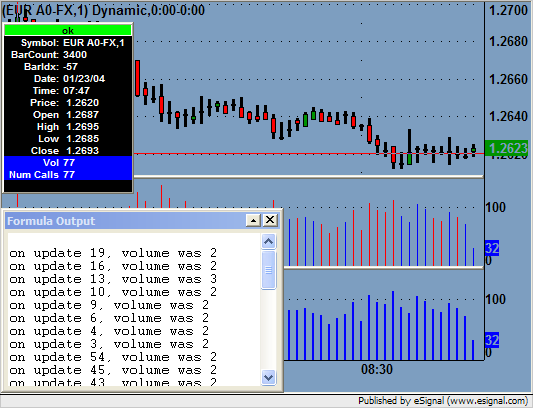Has anyone else had problems with an EFS NOT being invoked on each close?
I've wrote a small EFS to maintain a tic for the forex markets. I get some of the calls for each close over the course of the time frame for the bar, but the formula does not get called for every close. now I'm interpreting the doc, that the formula will be invoked each time that a lot has been bought/sold, not on a bid/ask changing. It seems very close to doing this, but there are calls to the formula not made. It's a small number of calls that are not made, lets say over the course of a minute, the volume (as shown by the volume study of the advanced chart) there are 80 lots that are sold, the formula may only be called say, 73 times.
Both an internal counter that I inserted into the formula, and the performance monitor support the fact that the formula is not being invoked every time there is a close. This ocurrs no matter which currency is being watched. One other thing that was interesting about this bug, is that, there were never any tics that were unchanged. I.E. last price = current price. That counter never changed, the up tick, down tick counters were being updated, but there were never any unchanged tics. Which is highly improbable. So i'm curious if the internal logic in e-signal doesn't invoke a formula if the current close = last close. This may have been done in order to save processing time, but it sure would mess up any form of average that was attemtped to be computed.
Thank anyone for their thoughts and help, as technical support, kept saying it was the script itself that I wrote which had the error, such is not the case.
I really like e-signal, and want to write more scripts, but want to be able to believe the data that is produced.
Jay Ice
I've wrote a small EFS to maintain a tic for the forex markets. I get some of the calls for each close over the course of the time frame for the bar, but the formula does not get called for every close. now I'm interpreting the doc, that the formula will be invoked each time that a lot has been bought/sold, not on a bid/ask changing. It seems very close to doing this, but there are calls to the formula not made. It's a small number of calls that are not made, lets say over the course of a minute, the volume (as shown by the volume study of the advanced chart) there are 80 lots that are sold, the formula may only be called say, 73 times.
Both an internal counter that I inserted into the formula, and the performance monitor support the fact that the formula is not being invoked every time there is a close. This ocurrs no matter which currency is being watched. One other thing that was interesting about this bug, is that, there were never any tics that were unchanged. I.E. last price = current price. That counter never changed, the up tick, down tick counters were being updated, but there were never any unchanged tics. Which is highly improbable. So i'm curious if the internal logic in e-signal doesn't invoke a formula if the current close = last close. This may have been done in order to save processing time, but it sure would mess up any form of average that was attemtped to be computed.
Thank anyone for their thoughts and help, as technical support, kept saying it was the script itself that I wrote which had the error, such is not the case.
I really like e-signal, and want to write more scripts, but want to be able to believe the data that is produced.
Jay Ice

Comment